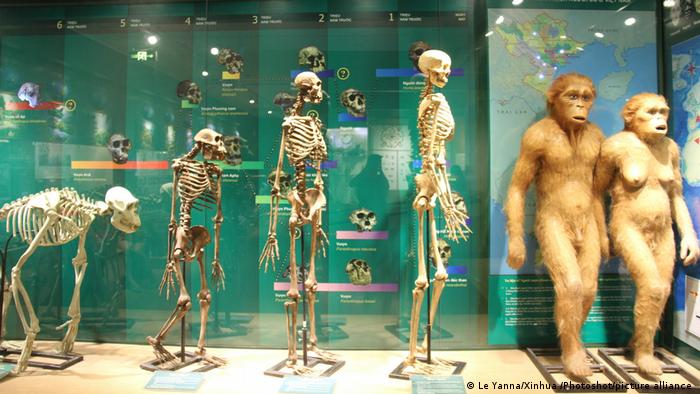SCIENCE
Here’s why we age
Against all evolutionary odds, humans are getting older and older. But why?
Photo taken on Aug. 29, 2015 shows the presentation of the evolution stages of human beings in Vietnam National Musuem of Nature in Hanoi, Vietnam.
Evolution is not a step-by-step process, but rather a constantly branching tree with many species going extinct throughout
Why do we get old?
This question has been troubling humans for thousands of years. Sadly, there is no definite answer yet — but here’s what we know so far.
System breakdown
As we age, many of the systems in our bodies begin to deteriorate: Our vision gets worse, our joints weaker and our skin thinner. The older we get, the more likely we are to become ill, break bones and — eventually — die.
Our reproductive success, which describes an individual’s production of offspring per lifetime, also declines as we age, Thomas Flatt, a professor of evolutionary biology at the University of Freiburg, told DW. “This is what happens to most organisms,” he said.
“Evolution by natural selection is very much about how many viable offspring you can produce,” said Flatt. The more viable offspring you produce, the more genes will be passed on — it’s all about maximizing reproduction.
Better genes are those that increase your reproductive sucess. Over generations, those genes are likely to become more common in the population.
Natural selection gets weaker as organisms age
This means that whatever happens after you reproduce has little effect on how well you pass on your genes to the next generation, which is key to understanding evolution.
Whether you are in a good or bad state when you get old doesn’t really matter, because you won’t be able to produce offspring.
Humans in the past, and most organisms that live in the wild, typically don’t reach old age because of the dangerous environments they grow up in.
This means that natural selection gets weaker in organisms as they age.
“To put it bluntly, organisms that are very old are, from an evolutionary perspective, worthless,” said Flatt.
A rare blue lobster, caught in the Atlantic, and delivered to Arnold’s Lobster & Clam Bar on Cape Cod, now has a new home at the St. Louis Aquarium at Union Station in St. Louis on Thursday July 11, 2019. The one-in-every two-million mutation won’t be cooked by the popular eatery but donated to St. Louis in honor of the St. Louis Blues’ Stanley Cup win. The lobster now has the name of Stanley
A blue lobster whose coloring is caused by a rare mutation
Accumulating mutations
Now imagine that by pure chance you inherit a dangerous mutation that will cause negative effects as you age. Although you most likely wouldn’t live long enough to experience those bad effects, the mutation would remain in your genome, so you would still be able to pass it on to your offspring.
This is happening all the time. Over generations, many mutations that make old age worse are accumulating in our genomes.
Huntington’s disease is thought to be an example of this accumulation of negative mutations. This deadly disease has an onset age of around 35 years.
There is also evidence that natural selection can favor some mutations that can have a positive effect at early age but negative effects when you get older, according to an article published by Flatt and Linda Partridge in BMC Biology.
An example of this includes mutations in the BRCA1/2 gene that increase a woman’s fertility — and the risk of women developing breast and ovarian cancer.
So what happens when modern medicine and improved diets, hygiene and living conditions allow us to live much longer? We live to ages in which we can experience all those negative effects.
Somniosus microcephalus – Greenland sleeper shark (Somniosus microcephalus) St. Lawrence River estuary, Canada NB: this shark was wild and unrestrained
The Greenland shark can live up to 400 years and is the oldest vertebrate
Why do some organisms live longer than others?
If we look at nature, aging is a very diverse process. Some organisms simply don’t seem to get old at all. Hydras are freshwater polyps, related to jellyfish and corals, that never seem to age and are potentially immortal.
There are also many plants that don’t show any signs of aging, and some trees, like the Great Basin bristlecone pine, that can live for thousands of years. One of these pines, named Methuselah, is almost 5,000 years old.
Another fascinating example is the Greenland shark. It reaches sexual maturity at age 150 and can live up to 400 years, giving it the longest lifespan of all vertebrates.
On the contrary, and perhaps to the delight of many, a female mosquito — the kind that bite you in your sleep — only lives about 50 days.
We still don’t know why these huge differences in aging and lifespan exist, but part of the answer is related to evolution. For different organisms, environmental pressures might have favored faster maturity and reproduction and shorter lifespan, while others favored the contrary.
“Animals that have a high risk of dying normally have a short lifespan, which of course makes sense, because if you have a very high risk to die anyway, you don’t need to invest in living very long,” Sebastian Grönke, a post-doctoral researcher at the Max Planck Institute for Biology of Aging, told DW. “You rather invest in reproducing fast so that you can reproduce before you die.”
From left, models representing Flores, Homo Sapiens and Neanderthal women stand in the Musee des Confluences, a new science and anthropology museum in Lyon, central France, Thursday, Dec. 18, 2014. The museum which originality and specificity are to link science and society, will be inaugurated this Friday and has been designed by Austrian architect Wolf Dieter Prix
Models representing different stages of female human evolution, including Flores, Homo Sapiens and Neanderthal women
Edited by: Clare Roth
DW RECOMMENDS
Necks for sex: How giraffes evolved to feed and breed
Giraffes are known for their long necks that allow them to feed on tall trees. But their necks may have evolved due to sexual combat, not the need to feed.
New academic study finds life expectancy on the rise
The life expectancy of people in developed countries keeps going up, according to research by London scientists. In some places it could soon be more than 90 – and the gap between men and women is decreasing, too.
Date 19.09.2022
Author Esteban Pardo
Keywords evolution, ageing, old, natural selection, lifespan
Feedback: Send us your feedback.
Print Print this page
Permalink https://p.dw.com/p/4Gq9N

























